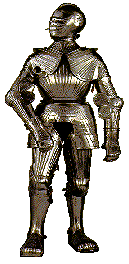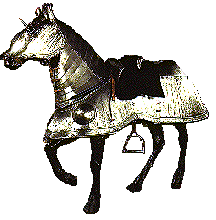 Imperial Austria: Treasures of
Art, Arms and Armor from the State of Styria
Imperial Austria: Treasures of
Art, Arms and Armor from the State of Styria
The Age of Emperor Maximilian I

Maximilian I (reigned 1493-1519) was constantly embroiled in politics and warfare. His idealism and crusading spirit earned him the title of "the last knight." He conducted campaigns against the Hungarians during the 1490s.
-
St. George, made in a workshop in the town of Villach
in Carinthia, Austria, c.1520; Filialkirche St. Leonhard, Murau.
Photo: Matthias Wimler
St. George wears the transitional armor of the early Maximilian period that, while fashionably rounded, retains such Gothic details as the rippled ribs on the breastplate, thighs, and arms, and the sallet helmet with bevor
Maximilian was a true Renaissance man. He was a writer and a great patron
of scholars and famous artists such as Albrecht Dürer and Hans
Burgkmair. In addition, he strongly supported the armorer's craft,
particularly in the imperial city of Innsbruck. Because of this patronage,
his name was given to a form of armor developed early in the 16th
century. "Maximilian" armor is characterized by its rounded surfaces
and broad-toed foot defenses. It is most often decorated with concave
flutes which imitate the folds of contemporary civilian clothing.
-
(left) Field armor of the "Maximilian Style"; made in
Innsbruck or Graz, 1510-1511, by Hans Maystetter; Joanneum Graz,
Landeszeughaus. Photo: Michael Oberer
Maystetter, whose mark appears on the left pauldron (shoulder defense), was first recorded in Innsbruck in 1508 and was called to Graz in 1510 at the emperor's command. His work is a superior example of field armor in the Maximilian fashion.
(right) Horse armor; school of Konrad Seusenhofer, probably made in Innsbruck 1505-1510; Joanneum Graz, Landeszeughaus. Photo: Richard Margolis
A knight's effectiveness greatly depended on his horse, which could be outfitted with varying amounts of armor, depending on its combat or sporting role. The aim was to protect above all its head, breast, flanks, and hindquarters. The most complete ensemble of horse armor was the full bard such as this one contemporary with Maximilian style armor. A knight had to be rich to outfit his mount in this way.
Maximilian knew the value of well-trained, professional footsoldiers, and created his own force of mercenary troops which he called Landsknechte. Recognizing the threat of imminent invasion of his Austrian territories, Maximilian actively undertook the military buildup of Styria. Here he constructed several armories and financed production of heavy guns.







